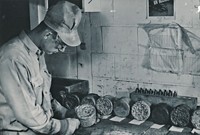Advertisement
Grab your lab coat. Let's get started
Welcome!
Welcome!
Create an account below to get 6 C&EN articles per month, receive newsletters and more - all free.
It seems this is your first time logging in online. Please enter the following information to continue.
As an ACS member you automatically get access to this site. All we need is few more details to create your reading experience.
Not you? Sign in with a different account.
Not you? Sign in with a different account.
ERROR 1
ERROR 1
ERROR 2
ERROR 2
ERROR 2
ERROR 2
ERROR 2
Password and Confirm password must match.
If you have an ACS member number, please enter it here so we can link this account to your membership. (optional)
ERROR 2
ACS values your privacy. By submitting your information, you are gaining access to C&EN and subscribing to our weekly newsletter. We use the information you provide to make your reading experience better, and we will never sell your data to third party members.
Programs
Pioneering steroid research earns National Historic Chemical Landmark
Innovations by the Upjohn Company paved the way for steroids such as hydrocortisone
by Linda Wang
July 12, 2019
| A version of this story appeared in
Volume 97, Issue 28

Steroids have revolutionized modern-day medicine, aiding in the treatment of a broad range of diseases, including arthritis, lupus, and multiple sclerosis. The pioneering research on steroids at the Upjohn Company was honored with a National Historic Chemical Landmark during a May 17 ceremony at the Kalamazoo Valley Museum in Kalamazoo, Michigan, where Upjohn was founded in 1886.
“Many of these modern drug therapies would not be available today without the pioneering research and development that occurred at Upjohn over an incredible 60-year period starting in 1930,” says American Chemical Society immediate past president Peter Dorhout. “The medicinal chemistry innovations, microbial and chemical transformation discoveries, and manufacturing processes developed by Upjohn for its steroid medicine program transformed not only the pharmaceutical industry but also the entire field of synthetic organic chemistry.”
In 1935, Upjohn became the first company to market an adrenocortical steroid product, and by the late 1940s, the company was also marketing androgens, estrogens, and progestogens. But because some of these steroids, such as cortisone, were extracted from animal products, the cost of making the steroids was high and the supply was limited.
In 1952, Upjohn biochemists Durey H. Peterson and Herbert C. Murray developed a fermentation process that converted progesterone into a hydroxylated precursor of cortisone, ultimately leading to a more efficient and low-cost way of producing cortisone. Over the next decade, Upjohn scaled up the production of a range of useful steroids, including hydrocortisone, which is commonly used today to treat skin rashes and other types of inflammation.

“By the mid-1950s the company had organized multiple teams to determine how best to optimize the synthesis of hydrocortisone for human clinical use,” says Donald R. Parfet, retired Upjohn officer and great-grandson of company founder William E. Upjohn.
By 1990, Upjohn scientists had created more than 30 steroids and analogs. “Today, cortisones, hydrocortisone, and later-generation steroid medicines resulting from these achievements continue to bring relief to millions of people and animals suffering from inflammatory, reproductive, and other disorders and diseases,” reads the commemorative plaque.
In addition to developing steroids, Upjohn researchers also created new tools in synthetic organic chemistry that led to more efficient ways of carrying out difficult reactions. Advancements included the development of the Upjohn dihydroxylation, which adds neighboring hydroxyl groups to alkenes with far less reliance on a toxic and expensive reagent called osmium tetroxide. Upjohn researchers also developed a process to upcycle waste materials from steroid production—specifically, developing a biocatalytic process to convert the accumulating by-product sitosterol into a potential precursor for other steroids.
In 1995, Upjohn merged with Pharmacia AB. The resulting company, Pharmacia & Upjohn, merged with Monsanto’s pharmaceutical operations in 2000 to create Pharmacia Inc. Pfizer acquired Pharmacia in 2003 and continues to operate the Kalamazoo manufacturing site where the original steroid research got its start.
ACS established the landmark program in 1992 to recognize seminal events in the history of chemistry and to increase awareness of the contributions of chemistry to society. Past landmarks include the discovery and production of penicillin, the invention of synthetic plastics, and the works of such notable scientific figures as educator George Washington Carver and environmental activist Rachel Carson. For more information about the National Historic Chemical Landmarks program, visit www.acs.org/landmarks.





Join the conversation
Contact the reporter
Submit a Letter to the Editor for publication
Engage with us on Twitter